Photos courtesy of Roland Sands Design
The great equalizer
Most forms of racing in the U.S. are seeing a decline in participation and with fans—grids are shrinking and stands are not filling up. The exception to this recent trend can be found on dirt tracks and small paved ovals all across the country. Flat track motorcycle racing is making a huge and rapid comeback in ways both predictable and unexpected.
On the professional level the revamped American Flat Track series launched last year amid a load of hype, big-money purses, a television package, and fan-friendly venues. New competition-only bikes from both Harley-Davidson and Indian fielding factory teams revived the Harley–Indian battles of the sport’s heyday and has brought new and old fans back to the major tracks.
In the amateur ranks, small tracks are experiencing an upswing in interest as new racers are discovering a way to go racing without the huge investment in time and money most other forms of motorcycle racing requires.
Then there is the new trend that seems to be redefining the sport—Hooligan racing, and its slightly younger, flashier sibling—Super Hooligan.
Hooligan racing is nothing new, although the name is. It harkens back to a time when any American could strip down a streetbike in the barn or a backyard shed, ride it to the track, race at a local track, and, if fortunate, ride it home again. It was American motor-sicle racin’ at its most basic and it’s been happening for a hundred years or so. But as anything fun grows, it gets organized and specialized and somewhat sterilized and it loses its grassroots foundation.
A few years ago some Southern California flat tracks began hosting “Harley Nights” at local races with the intent of reintroducing the fun factor along with a side helping of silliness by adding a class for street bikes. People could show up with dressers, baggers, choppers, bobbers, trackers, Softails with ape hangers, and other street-legal bikes, probably fueled with an equal mixture of PBR for the rider and pump gas for the tank, and race. The action was predictably wild and rowdy with lots of crashes and collisions. And the stands began to fill.
Then a couple guys showed up on old Sportsters… and the race was on!
A few decades ago Harley-Davidson sponsored a flat track series for 883 Sportsters and those old bikes became the prototype for the new Hooligan class. The rules are simple: basically any street bike with a 750cc or larger engine, a stock frame, 19-inch wheels for dirt track tires, and no front brakes. (The bike’s geometry cannot be altered; you can’t change steering-head angle or triple trees to get sharper steering. But if you happen to hit a wall at speed and bend the forks a bit and gain the same result, the bike hasn’t been altered, it’s been crashed, and you’ll probably pass tech.)
The perfect Hooligan starter bike is an old Sportster that’s been sitting out in the rain for a couple years and can be had for a grand or two. Clean it up. Strip it down. Change the fluids. Put on good rubber. Get the moving bits and the electric parts in proper order. And go racing! No license or prior track experience is required. But there is no umbrella sanctioning body for the series and some promoters may require racers belong to the AMA, or if it’s a Harley-Davidson-sponsored race they may stipulate that only Evo Sportsters qualify for entry.
The rule package is all pretty much ad hoc as far as promoters are concerned. Most Hooligan races are trophy races without any payout for winners with the intention of keeping it fun and casual. Most races are associated with other established flat track events or one of the current motorcycle shows such as Mama Tried in Milwaukee. The Harley Hooligan series runs at the youth-orientated X Games, and got invited to race at this year’s American Flat Track season opener in Daytona.
Whereas Hooligan racing is a racer’s series that fans enjoy, the Super Hooligan series is intended to be a show—“a party where a race broke out” Roland Sands Design calls it—for the fans, featuring prize money, known racers and stricter rules. It runs an 11-race, points-paying series, with any rider’s nine best finishes counting towards the championship. The race winner of each round gets a sizable purse, the rider who gets through Turn #2 first gets paid for that achievement, and a cash award goes to the most dramatic crash of the evening. The series champion will receive a new Indian motorcycle customized by Roland Sands Design at the final race of the season in October.
Although Super Hooligan is strictly an amateur series, the prize package, the status of racing with celebrity builder Roland Sands, and the novelty of racing such a new, exciting action-packed series has brought retired flat track champions back to the grid. Famous road racers enjoy getting off their usual, highly-technical, 200-mph paved tracks to try their skills in the dirt, and current professional riders from the American Flat Track series enter occasional rounds just for the fun of it. And anyone is welcome to show up and join in on the fun.
Roland Sands began the Super Hooligan series when Indian supplied him with five Indian Scout Sixtys (60 c.i./983cc engines) for him to customize into Hooligan racers. He formed his team around those bikes and other riders mounted on their own race-prepped Indians, Harley-Davidson XG750s, Ducati Scramblers, Triumph Bonnevilles, and the odd BMW R nineT round out the grid. Any brand is allowed as long as it meets the specs of the series. Most of the competitions are affiliated with shows or races just as the regular Hooligan races are, but they also promote their own standalone races—on a beach in Southern California, under a pier in San Francisco, or in a parking lot in Austin, Texas, when the international MotoGP series came to the U.S. a couple years ago.
There is some grumbling among the Hooligan ranks that Super Hooligan is corrupting the purity of grassroots racing, and there may be some legitimacy to that argument. It does sort of blur the line between amateur and professional, something both Indian Motorcycle and RSD representatives acknowledged in phone interviews. But as Cameron Brewer, RSD project manager, says, “The bike is the equalizer. It’s a heavy bike that’s doing something it was never designed to do. You can see guys you’ve never heard of racing against champions.”
I guess that’s the true beauty of this series; anyone can buy a regular street bike, and modify it for less that the price of a good used car and be on equal equipment battle against their idols. And if they have the talent, they’ll get the win.
Isn’t that what the American dream is really all about, starting out on equal ground and testing yourself against the best? And what better way to achieve that than racing motorcycles in America’s original grassroots racing series? No other type of racing anywhere offers that.
For the 2018 Super Hooligan racing schedule, go to thunderpressed.wpengine.com/competition and select “Click here for the 2018 schedules…”


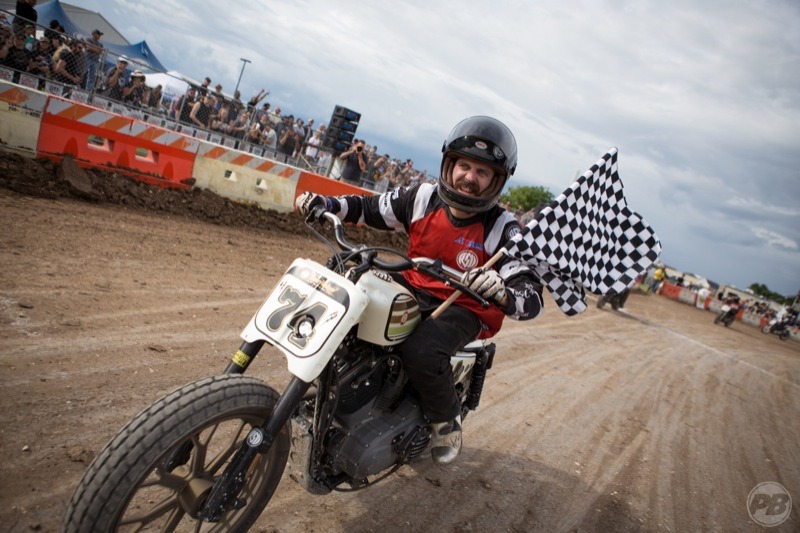




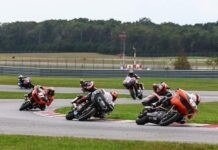
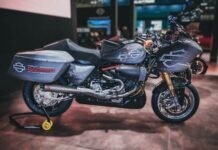
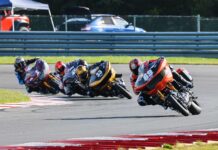


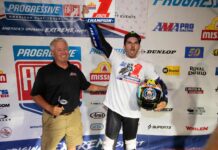










What a beautifully writing piece. It captures the spirit of these riders perfectly
I admire riders and I love watching track racing whether it is flat track or exhibitions. They are all heart stopping. I’m actually a frustrated rider. Lol!
Too bad Roland Sands brought Pro Riders into
A amateur event To try to dominate something fun
Just like Almost everything Out there Big Money n people W Deep Pockets try to Ruin it For the Average Joe Blow I am sure you Won’t print my Opinion but wanted to get off my Chest Indian Motorcycles n Roland Sands did Just that For Hooligan Racing But They Got Voted Out !!!!!!!!!!